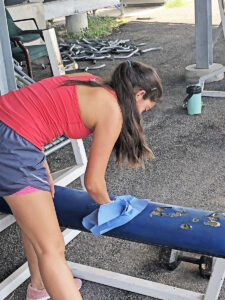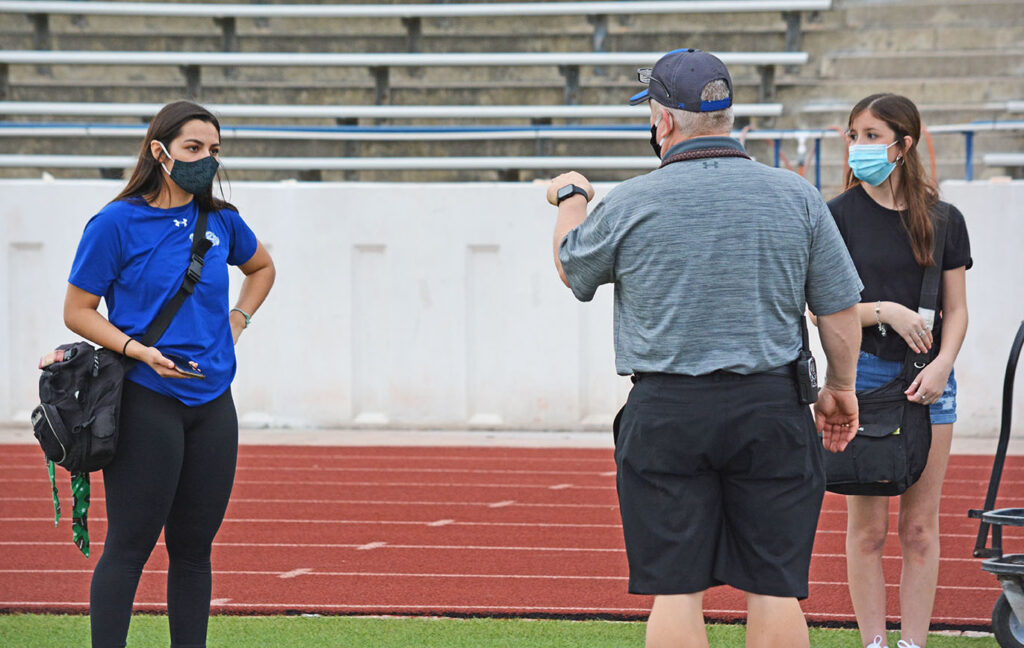By Brian Argabright
For years, the athletic training department at Del Rio High School has been working to aid injured student-athletes from the time of their injury through rehab and then in the aftermath to hopefully help those athletes from getting injured again.
But now the team is stepping up its role of ally for healthcare professionals as they work to keep student-athletes, coaches and anyone else associated with sports safe during the ongoing coronavirus pandemic.
Brad “Doc” Dixon has been the head athletic trainer in the San Felipe Del Rio CISD for 24 years, but according to Dixon, this year has been the most challenging in his career.
“I can’t imagine a more difficult year than this. This sets the bar for level of difficulty. The amount of things we’ve had to change in order to maintain the health of our athletes has been unprecedented. When this is over I can’t imagine having to complain about anything else again, “ Dixon said. “Mentally, emotionally, physically … we put in more hours working right now because of the new requirements, especially during football season. There were things that made it much more difficult because we had to have all the separate practices and the other issues we had to deal with. But it’s what we do and you do what you have to do as an athletic trainer.”
While the COVID-19 strain of the coronavirus had been prevalent in different parts of the world since the earliest weeks of 2020, it wasn’t reported in Texas until March. Texas’ University Interscholastic League, UIL, the governing body of school athletic, academic and musical competition, then suspended activities March 16 with a targeted return date of March 29.
It would be months before athletes were permitted to return to any kind of school-sanctioned activity.
“We knew in our heads something was going to change from the day they told us we were going home. We didn’t know what it was going to look like but first time we really had any idea how our world was going to change was early June. That’s when the CDC (Center for Disease Control) and UIL and the National Federation of High Schools started putting out guidelines,” Dixon said. “School was over, but now we were facing the summer which meant strength and conditioning camps. It was then we really knew how much was going change.”
Those changes included limiting the number of participants that would be allowed at the summer strength and conditioning camps. The fewer participants, the easier it would be for them to practice social distancing by staying apart at least six feet while working out. It also allowed Dixon and his team to be able to take the temperatures of everyone who attended the camps, to check for elevated body temperature, which is a possible sign of the coronavirus, and help oversee the cleaning and disinfecting of equipment in between sessions.
Many of those precautions were born out of Dixon and school district administrators’ ongoing education regarding the virus.
“We studied it. We usually had our student trainer camp during the summer, but as soon as all this started happening we knew that the way we presented the camp, the method, was going to have to change. We knew what was presented to the kids was significantly going to change. Now we had a new, more important section we had to go over with them.”
“We started, as a group, as a staff, looking for all the info we could find. We called friends who were trainers. We talked to a variety of people, we talked to our doctors and asked them what they had been doing, what they see for us, having worked with us, and what did they reasonably expect us to be able to do within these guidelines. We had them propose some additional guidelines for us,” Dixon continued. “The big thing, for us, was seeking out all the info we could whether it was from the CDC, UIL, NCAA, National Federation of High Schools, etc. We scoured ever piece of information we could and then looked for people who were condensing all that into a universal guidebook and from that point the staff together started making suggestions for what we would be able to do at the high school. That included how we would see patients, especially our numbers we would be allowed to have inside the facility. If we couldn’t fit everyone, would we create a new outdoor facility to compensate for that? The big thing at that time was no one was allowed or wanted to stay indoors and we weren’t used to doing rehab or treatment outdoors, so we had to figure out how to do that.”
Dixon was quick to point out it wasn’t a one-man, or a one-team show. He said Ric Smith, the school district’s athletic director, took the lead in reaching out and asking for

A Del Rio High School student-athlete wipes down a bench prior to its usage during
this year’s summer workout and conditioning camps at the school. Masks, social distancing and sanitization of workout equipment and playing equipment has been key in keeping COVID numbers low among student-athletes and staff. (Photo courtesy of Rod Taylor)
suggestions from other school districts and offering his team a broad outline of what needed to happen and then ask coaches and the training staff how they planned on making it happen.
“Sometime the suggestions were good and sometimes we needed to revise those ideas. Early on we were all in a constant stage of revision. It’s not that what we were doing wasn’t working, but we needed to find a more efficient way to do what we did,” Dixon said.
The next big obstacle for Dixon and the athletic training team was the influx of students that would be returning once the high school reopened. With the decision to cancel middle school and junior varsity sports and non-athletic UIL competitions for this season, the focus was set on varsity sports and high school activities.
“Now we had to go back and look like how we were going to handle all these new students. We knew what we did outside worked, but what were we going to do inside? How many trainers can work inside? How will we treat people inside? When all these kids start coming back, what will be the process of checking them in? We had to have a new plan for bringing in a bunch of new people. We couldn’t do sessions during school because they all had to come in after school. We had to focus on a new game plan with new requirements,” Dixon said.
Much like many of the athletic programs at the high school, some of Dixon’s expected returners opted not to return to school or the program out of safety precautions regarding the coronavirus. Dixon said it wasn’t many of his student trainers, but added that he did have students who chose to join athletic training after school, putting the team’s numbers back at their usual level.
Del Rio High School’s athletic teams haven’t had the COVID-19 issues many other schools have had. Some schools have had to cancel their seasons due to the virus, others have had to forfeit or reschedule games. Del Rio has had a handful of positive cases among its athletic teams, but they were isolated and did not spread to put their seasons in jeopardy.
Dixon credits that kind of success rate to constant education and preparing his student trainers, who are teenagers, on how to properly deal with a virus that has led to more than 300,000 deaths nationwide. He said it hasn’t been easy at all, especially early on, but he said his students have stepped up to the challenge and are combatting fear with education.
“ I think educating them to the best of our ability is the thing that helps the most. When they know what they have to do, what they’re expected to do, how this disease works and transmits itself … when they understand those precautions and how it helps them, helps them understand and feel more comfortable, it’s because of that and because we haven’t seen significant numbers of transmission within our programs. All of that adds confidence that what they’re doing keeps them safe, or as safe as we can in this world,” Dixon said. “We were ready. We had a plan. We put as much thought into it as possible and still every day we looked back and said what we could we do better. I want to credit our kids and staff, all our trainers, on the work they’ve done this year.”
Nine months into this pandemic and there is now a vaccine being distributed to members of the public. Nearly 200,000 people have already received the vaccine, and more is on the way. However, the recovery period for the nation is still unknown, so a return to any resemblance of normal is still off in the horizon. Dixon said fear won’t help move the mark any closer to “normal” but all of the education, preparation and trial and error he and his staff have been through has made a lot of difference.
“I still think we learn a little bit every day, not as much as before. (What we do) has not become automatic yet, but I think we feel more comfortable with what we have to do. There’s still some apprehension everyday knowing that outside, even in the school itself, we’re still getting cases. We know that it’s here, and we don’t feel that things have gone back to any sort of normal. We do learn a little bit of everything and we’re tweaking things. As new sports start, we know we will have to make some changes in logistics, like where we move people and how we do check-ins. It’s not normal yet, but it’s easier,” Dixon said.


